- Home
- Garden Wildlife
- Insects
- Orthoptera
- Grasshoppers
Grasshoppers and groundhoppers
Grasshoppers and groundhoppers are insects that belong to the order Orthoptera
Groundhoppers are 8-14mm in length and are blackish brown with variable amounts of white or pale brown markings. They differ from grasshoppers in their pronotum, extending back as a sharp-pointed posterior extension of the top of the prothorax that covers the rest of the thorax and most of the abdomen. Grasshoppers are generally green or greyish brown in colour, but some species are very variable in colour. Most UK grasshoppers are in the size range 12-20mm. Their pronotum does not extend over the abdomen and resembles a saddle when the insect is viewed from the side.
Field Grasshopper Chorthippus brunneus male Common groundhopper Tetrix undulata
Species in Britain and Ireland
There are 13 species of grasshopper and three groundhoppers native to Britain and Ireland. Some of these grasshoppers have special habitat requirements, such as bogs, woodland or heathland. The species most likely to be seen in gardens are the field grasshopper Chorthippus brunneus, and the meadow grasshopper, Chorthippus parallelus. Jennifer Owen found both species in her Sheffield garden. The latter is very variable in colour and sometimes occurs in a pinkish purple form. These two grasshoppers generally live in tall grasses and other rank vegetation, so are more likely to occur in gardens especially the lawn is cut infrequently.
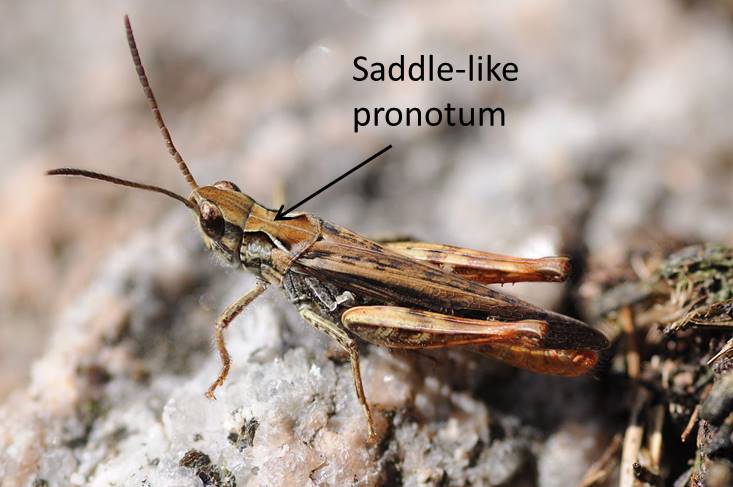
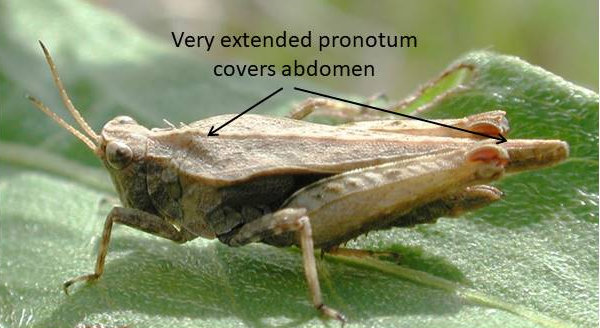
Field Grasshopper Chorthippus brunneus female Meadow grasshopper Chorthippus parallelus male
Groundhoppers are less frequently seen in gardens. The common groundhopper, Tetrix undulata, lives in a wide range of habitats and is widespread in Britain and Ireland. The slender groundhopper, Tetrix subulata lives in wet situations and so might be found near ponds, particularly if there is wet ground surrounding the pond. The third species is Cepero’s groundhopper, Tetrix ceperoi, a coastal species found in some locations along the south coast of England and Wales.
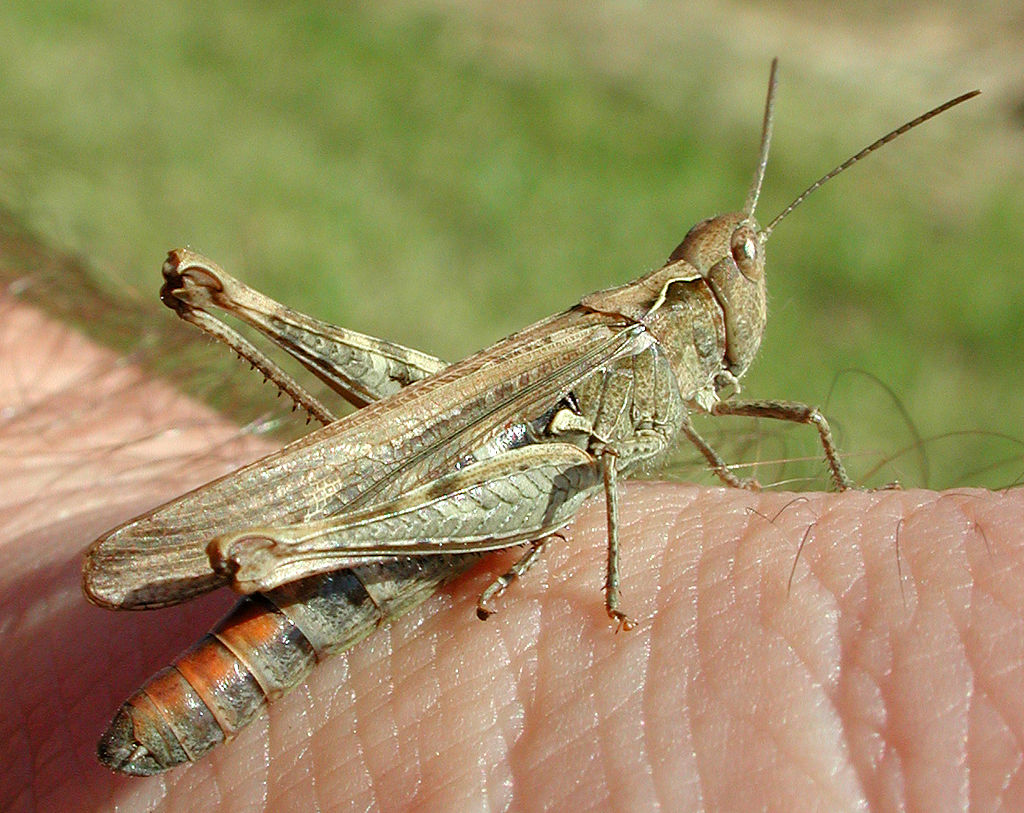
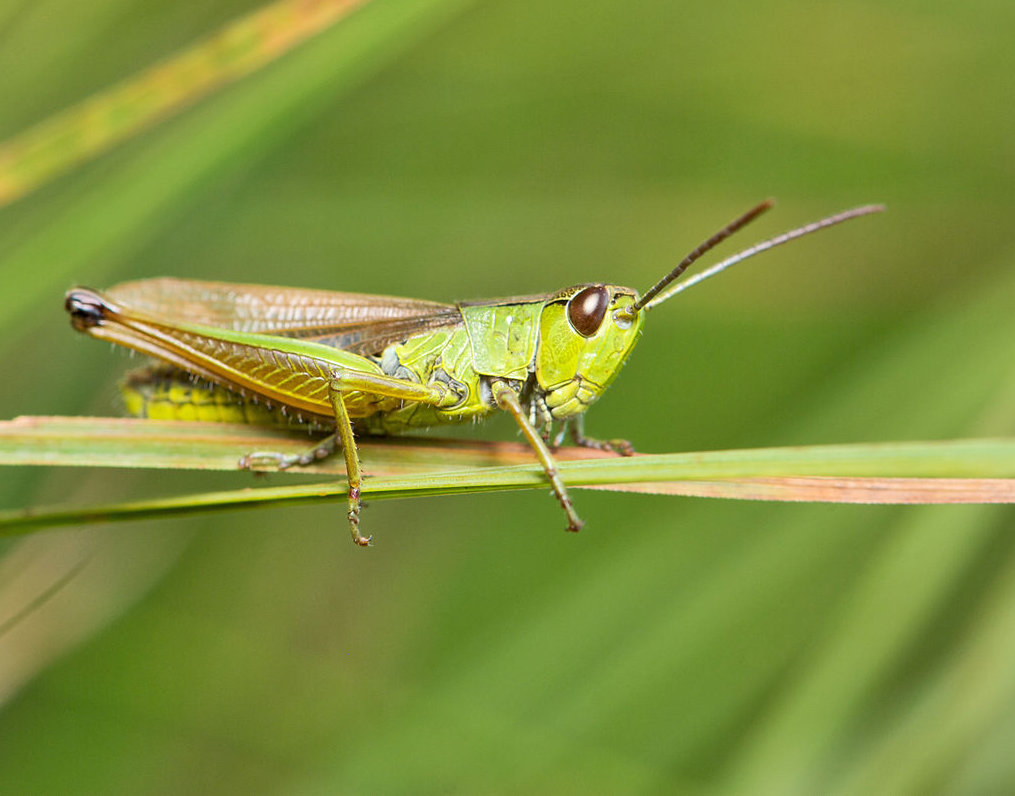
Common groundhopper Tetrix undulata Slender groundhopper Tetrix subulata
Biology
Grasshoppers eat the foliage of a wide range of plants, especially grasses. Groundhoppers feed on mosses and algae. Adult male grasshoppers stridulate by rubbing their hind legs against their wings. The sound is used to attract mates. Groundhoppers do not stridulate. Some species, such as the common groundhopper and female meadow grasshopper have reduced wings and are unable to fly. Groundhoppers can, however, swim if they are immersed in water.
Life cycle
Grasshoppers become adult in late summer. Females lay batches of eggs by inserting the end of their abdomen and ovipositor into the soil. A frothy secretion is produced that hardens around the eggs to form an egg pod. The eggs overwinter and hatch in late spring. Grasshopper and groundhopper nymphs resemble the adult insects, with the wings gradually forming as the nymphs increase in size. Grasshoppers have four nymphal stages, whereas groundhoppers have five or six.
Groundhoppers deposit their eggs in mosses or in crevices in the soil during late spring and summer. The eggs hatch a few weeks later and the overwintering stage is the adult or nymphs.
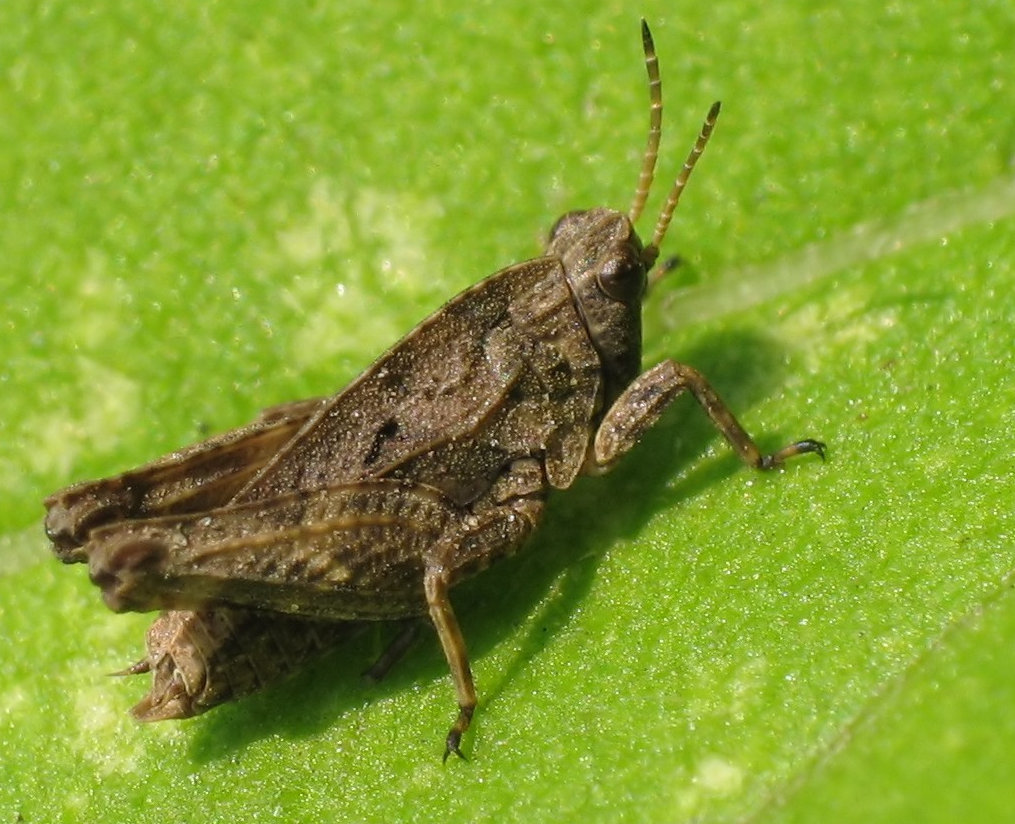
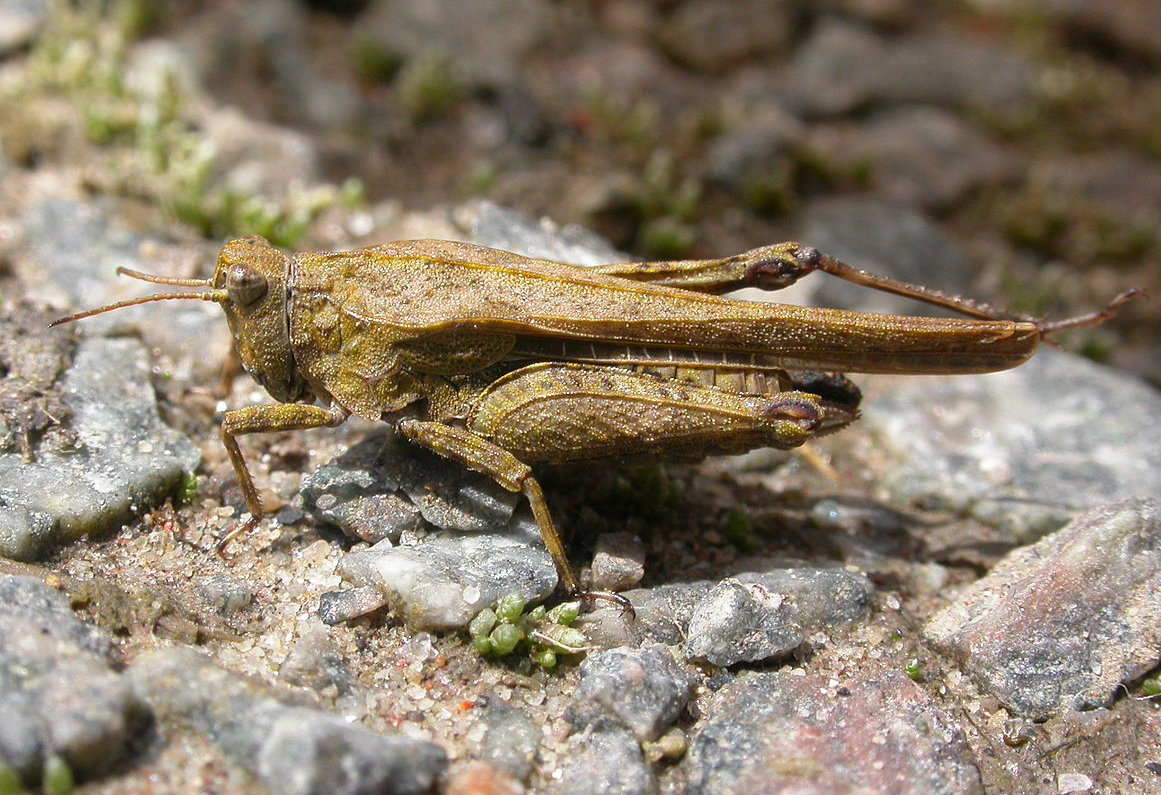
Meadow grasshopper Chorthippus parallelus nymph Common groundhopper Tetrix undulata nymph
Role of grasshoppers and groundhoppers in gardens
Grasshoppers and groundhoppers are not usually present in gardens unless there are areas on long grass. The chirruping songs of grasshoppers is an accompaniment to summer.
Other sources of information
Website
Website of the grasshoppers and allied insects recording scheme of Britain and Ireland
Identification guide to grasshoppers and crickets of the UK
UK Orthoptera Facebook Group
Books
Benton, T. (2012) Grasshoppers and Crickets. Collins New Naturalist series no 120. Harper Collins
Brown, V. (1990) Naturalist’s Handbook 2 Grasshoppers. Richmond Publishing
Marshall, J. A. & Haes, E. C. M. (1988) Grasshoppers and allied insects of Great Britain and Ireland. Harley Books
Page text drafted by Andrew Halstead, reviewed by Andrew Salisbury, compiled by Steve Head
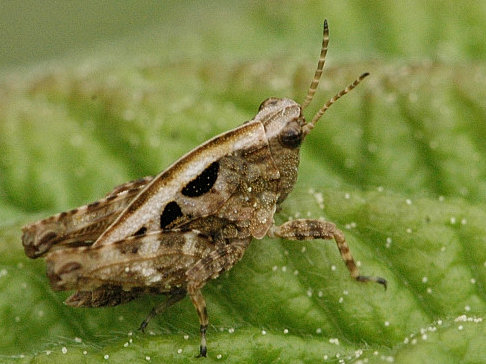
_nymph.jpg)
Field Grasshopper Chorthippus brunneus Common groundhopper Tetrix undulata
Species in Britain and Ireland
There are 13 species of grasshopper and three groundhoppers native to Britain and Ireland. Some of these grasshoppers have special habitat requirements, such as bogs, woodland or heathland. The species most likely to be seen in gardens are the field grasshopper Chorthippus brunneus, and the meadow grasshopper, Chorthippus parallelus. Jennifer Owen found both species in her Sheffield garden. The latter is very variable in colour and sometimes occurs in a pinkish purple form. These two grasshoppers generally live in tall grasses and other rank vegetation, so are more likely to occur in gardens especially the lawn is cut infrequently.


Grasshoppers and groundhoppers
Grasshoppers and groundhoppers are insects that belong to the order Orthoptera
Groundhoppers are 8-14mm in length and are blackish brown with variable amounts of white or pale brown markings. They differ from grasshoppers in their pronotum, extending back as a sharp-pointed posterior extension of the top of the prothorax that covers the rest of the thorax and most of the abdomen. Grasshoppers are generally green or greyish brown in colour, but some species are very variable in colour. Most UK grasshoppers are in the size range 12-20mm. Their pronotum does not extend over the abdomen and resembles a saddle when the insect is viewed from the side.


Left: Field Grasshopper Chorthippus brunneus female Right: Meadow grasshopper Chorthippus parallelus male
Groundhoppers are less frequently seen in gardens. The common groundhopper, Tetrix undulata, lives in a wide range of habitats and is widespread in Britain and Ireland. The slender groundhopper, Tetrix subulata lives in wet situations and so might be found near ponds, particularly if there is wet ground surrounding the pond. The third species is Cepero’s groundhopper, Tetrix ceperoi, a coastal species found in some locations along the south coast of England and Wales.


Left: Common groundhopper Tetrix undulata Right: Slender groundhopper Tetrix subulata
Biology
Grasshoppers eat the foliage of a wide range of plants, especially grasses. Groundhoppers feed on mosses and algae. Adult male grasshoppers stridulate by rubbing their hind legs against their wings. The sound is used to attract mates. Groundhoppers do not stridulate. Some species, such as the common groundhopper and female meadow grasshopper have reduced wings and are unable to fly. Groundhoppers can, however, swim if they are immersed in water.
Life cycle
Grasshoppers become adult in late summer. Females lay batches of eggs by inserting the end of their abdomen and ovipositor into the soil. A frothy secretion is produced that hardens around the eggs to form an egg pod. The eggs overwinter and hatch in late spring. Grasshopper and groundhopper nymphs resemble the adult insects, with the wings gradually forming as the nymphs increase in size. Grasshoppers have four nymphal stages, whereas groundhoppers have five or six.
Groundhoppers deposit their eggs in mosses or in crevices in the soil during late spring and summer. The eggs hatch a few weeks later and the overwintering stage is the adult or nymphs.
Left: Meadow grasshopper Chorthippus parallelus nymph Right: Common groundhopper Tetrix undulata nymph
Role of grasshoppers and groundhoppers in gardens
Grasshoppers and groundhoppers are not usually present in gardens unless there are areas on long grass. The chirruping songs of grasshoppers is an accompaniment to summer.
Other sources of information
Website
Website of the grasshoppers and allied insects recording scheme of Britain and Ireland
Identification guide to grasshoppers and crickets of the UK
UK Orthoptera Facebook Group
Books
Benton, T. (2012) Grasshoppers and Crickets. Collins New Naturalist series no 120. Harper Collins
Brown, V. (1990) Naturalist’s Handbook 2 Grasshoppers. Richmond Publishing
Marshall, J. A. & Haes, E. C. M. (1988) Grasshoppers and allied insects of Great Britain and Ireland. Harley Books
Page text drafted by Andrew Halstead, reviewed by Andrew Salisbury, compiled by Steve Head

_nymph.jpg)












